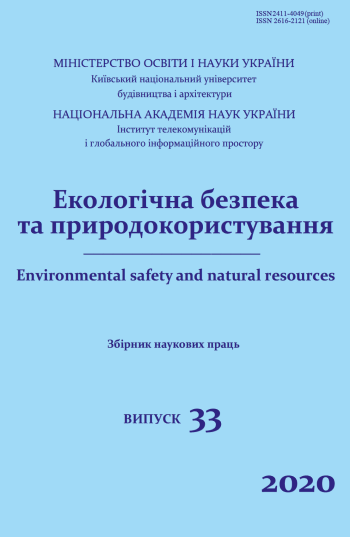Рathfinder elements of uranium mineralization from albitite formation of the Ukrainian shield and their impact on the environment
DOI:
https://doi.org/10.32347/2411-4049.2020.1.42-58Keywords:
Ukrainian Shield, uranium mining, albitite formation, uranium and its pathfinder elements, heavy metals, hazard category, environmental impactAbstract
The uranium ore albitites were studied emphasizing the regularities of concentration and dissemination of various elements in the process of formation and destruction of deposits for this formation. The elements typification was made with the following groups identified: radioactive, siderophilic, chalcophilic, rare elements, rare earth elements, and elements-mineralizes. Their impact on the environment was considered. Almost all known uranium deposits of the albitite formation of the Ingulskyi megablock of the Ukrainian Shield have always been considered as mono-elemental, exclusively uranium associations. However, gold, bismuth mineralization, as well as associated with monazite thorium, are found in commercial quantities within albitites deposits. These components could have been of a related commercial value. Enhancing amount of vanadium, strontium, lead and some other elements are also often met. In the process of uranium mining all mentioned elements, including uranium, are followed into refuse heaps and tailings. Taking into account geological and geochemical conditions, the region of albitites deposits development is seemed to be favorable for formation of near surface uranium and pathfinder elements concentrations. The uranium mining tailings enriched in uranium and heavy metals are being stored within the sanitary zones of operating mines and considered as to be favorable for oxidation and decomposition under the conditions of hypergenesis. The mentioned processes can last for an indefinite time taking into account mineral composition of loose deposits, climate changes, and fluctuations in the level of groundwater in the region. And, if natural secondary concentrations of uranium and its pathfinder elements can be considered as mineral resources, then dissemination of these elements in waters, soils and biological objects is likely to be attributed to very harmful processes. At the same time, the removal of heavy metals by atmospheric waters is absolutely predictable, with their subsequent migration into the groundwater system, gradual penetration into soils and biological objects, which undoubtedly carries a potential threat to the environment.References
Belevtsev, Y.N., & Koval, V.B. (Eds. in charge). (1995). Geneticheskie tipu i zakonomernosti razmeshcheniya uranovykh mestorozdenii Ukrainy. [Genetic types and regularities of localization of uranium deposits of Ukraine]. Kyiv: Nauk. Dumka. (in Russian)
Verkhovtsev, V.G. et al. (2014). Perspektyvy rozvytku uranovoi syrovynnoi bazy yadernoi energetyky Ukrainy. [Prospects for the development of uranium resource base of nuclear power of Ukraine]. Kyiv: Naukova Dumka. (in Ukrainian)
Dudar, T.V., Zaktytnyi, Ye.Ye., & Bugera, M.A. (2015). Uranium Mining and Associated Environmental Challenges for Ukraine. Science-Based Technologies, 1(25), 68-73.
Michel Cuney et al. (2012). Uranium deposits associated with Na-metasomatism from central Ukraine: A review of some of the major deposits and genetic constraints. Ore Geology Reviews, 44, 82-106.
Sushchuk, К.G., & Verkhovtsev, V.G. (2019). Metalogeniya uranu v fanerozoi platformenoyi chastunu Ukrainu [Metalogeny of uranium in Phanerozoic of the sedimentary part of Ukraine]. Geokhimiya tekhnogenezu (Zb. Nauk. Prats’ IGNS NAN Ukrainu), 2(30), 56-69. (in Ukrainian)
Belevtsev, Y.N. (Eds. in charge). (1968). Zaconomernosti obrazovaniya I razmeshcheniya uranovykh mestorozdenii Ukrainy. [Regularities of formation and localization of uranium deposits of Ukraine]. Kyiv. (in Russian)
Voitkevich, G.V., Kokin, A.V., Miroshnikov, A.Ye., & Prokhorov, V.G. (1990). Spravochnik po geokhimii. [Geochemistry reference]. Moscow: Nedra. (in Russian)
Tokarev, A.N., Kupel, Ye.N., Popova, T.P., et al. (1975). Radiogidrogeologicheskii metod poiskov mestorozdenii urana. [Radihedrogeological method for uranium deposits surveing]. Moscow: Nedra. (in Russian)
Belevtsev, Ya.N., Yegorov, Yu.P., Titov, V.K. et al. (1975). Srednie soderzaniya urana i toriya v glavneishyh tipakh gornykh porod Ukrainskogo Shchita. [Average content of uranium and thorium in the major types of rocks of Ukrainian Shield]. Geol. Zurnal, 35(4), 96-117. (in Russian)
Yesipchuk, R.Ye., Sheremet, Ye.M., Zinchenko, O.V. et al. (1990). Petrologiya, geokhimiya s rudonostost intrusivnykh granitoidov Ukrainskogo shchita. [Petrology, geochemistry, and ore formation in intrusive granitoids of the Ukrainian Shield]. Kyiv: Nauk. Dumka. (in Russian)
Shcherbakov, I.B. (2005). Petrologiya Ukrainskogo Shchita. [Petrology of the Ukrainian Shield]. Lviv: ZUKTS. (in Russian)
Tugarinov, A.I., Balashov, Yu.N., & Gavrilova, P.K. (1973). Raspredeleniye redkozemelnykh elementov v krivorozskoi serii nizhnego proterozoya [Distribution of rare earth elements in Kryvorizzya series of Lower Proterozoic]. Geokhimiya, (1), 28-34. (in Russian)
Mineev, D.A. (1974). Lantanoidy v rudakh redkozemelnykh I kompleksnykh mestorozhdeniyakh. [Lantanoids in ores from rare earth and complex deposits]. Moscow: Nauka. (in Russian)
Balashov, Yu.N., & Goryainov, P.M. (1966). Redkozemelnye element v dokembriiskoi zhelezorudnoi frmatsii Pryimandrovskogo raiona. [Rare earth elements in Pre-Cambrian iron formation of Ptyimandrovskii region]. Geokhimiya, (3), 312-322. (in Russian)
Geokhimiya, mineralogiya i geneticheskie tipy mestorozdenii redkikh elementov, v. 1 [Geochemistry, mineralogy and genetic types of rare elements deposits, v. 1]. (1964). Moscow: Nauka. (in Russian)
Korznev, M.N., & Fomin, Yu.A. (1992). Evolyutsia uslovii nakopleniya porod krivorozskoi serii po geokhimicheskim s szotopnym dannym. [Evolution of accumulation conditions of Kryvorizzya series rocks on geochemical and isotopic data]. Geol. Zurnal, (3), 93-99. (in Russian)
Usenko, I.S., Rokachuk, T.A., Kramarenko, N.K. et. al. (1980). Shchelochnye polevyeye shpaty granitoidov Ukrainskogo Shchita. [Alkaline feldspars from granitoids of the Ukrainian Shield]. Kyiv: Nauk. Dumka. (in Russian)
Downloads
Published
How to Cite
Issue
Section
License
Copyright (c) 2020 Yuri O. Fomin, Yuri M. Demikhov, Valentyn G. Verkhovtsev, Tamara V. Dudar, Natalya N. Borisova, Zinaida N. Kravchuk

This work is licensed under a Creative Commons Attribution 4.0 International License.
The journal «Environmental safety and natural resources» works under Creative Commons Attribution 4.0 International (CC BY 4.0).
The licensing policy is compatible with the overwhelming majority of open access and archiving policies.

